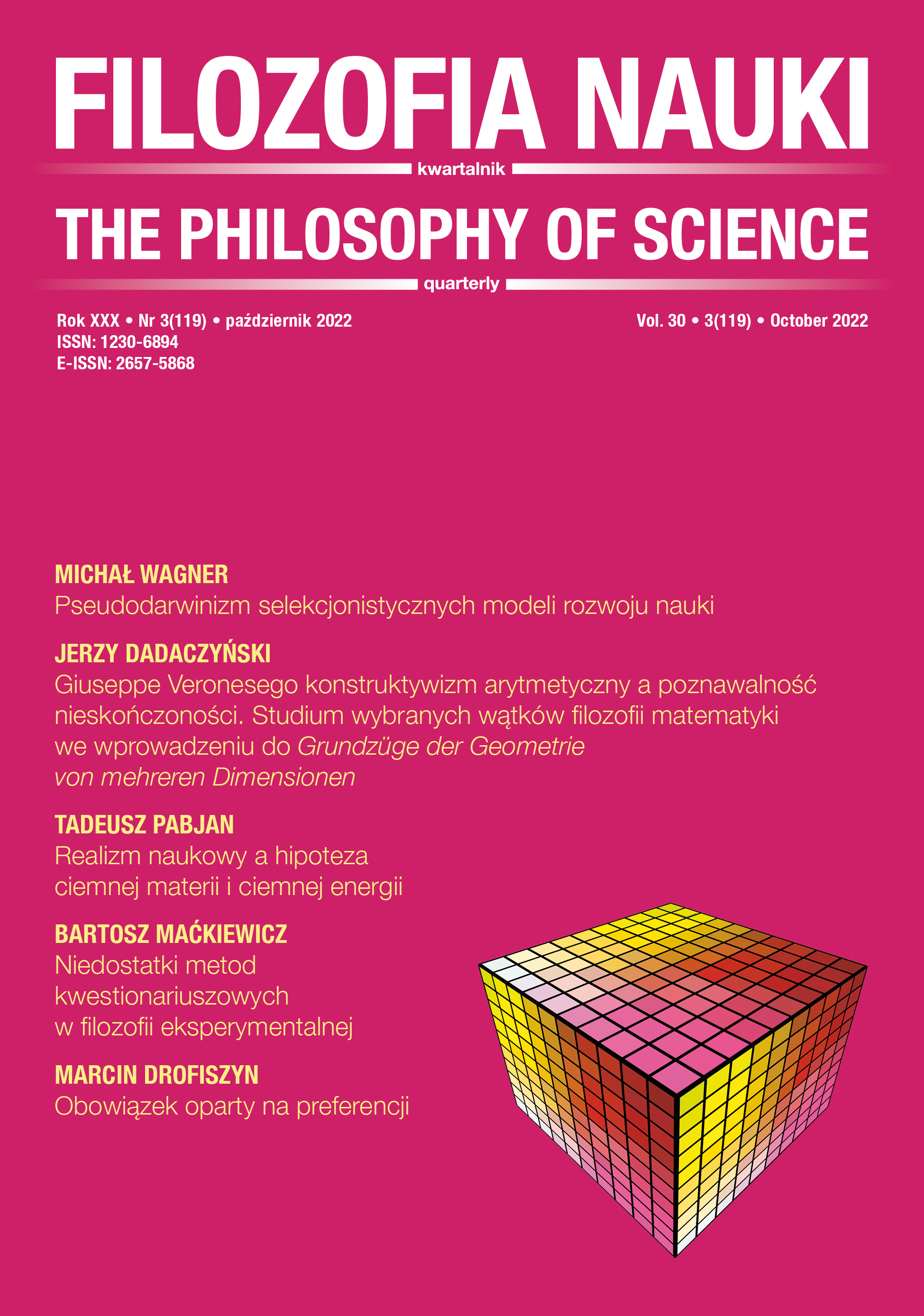Scientific Realism and the Hypothesis of Dark Matter and Dark Energy
DOI:
https://doi.org/10.14394/filnau.2022.0028Keywords:
scientific realism, anti-realism, half-realism, dark matter, dark energy, missing mass problemAbstract
One of the essential aspects of the dispute between scientific realism and anti-realism is the question of the ontological status of unobservable objects assumed by scientific theories and models. Scientific realism claims that these objects exist in the natural world, while anti-realism denies this. The missing mass problem is a good example of an issue that requires that this question be resolved. In cosmology, this problem is solved by assuming the presence of dark matter and dark energy. The difficulty, however, is that experience does not provide direct evidence for the existence of these two „substances.” In the first part of the article, the differences between scientific realism and anti-realism are discussed. In the second and third parts, the problem of the missing mass is presented (special attention is paid to the difficulties with the empirical confirmation of the existence of dark matter and dark energy). The fourth part of the article discusses the arguments of the supporters of half-realism, which is a kind of compromise between scientific realism and anti-realism.
References
Bolejko K., Célérier M. N., Krasiński A. (2011), Inhomogeneous Cosmological Models: Exact Solutions and Their Applications, „Classical and Quantum Gravity” 28, 164002, 1-30. https://doi.org/10.1088/0264-9381/28/16/164002
Cartwright N. (1983), How the Laws of Physics Lie, Oxford: Oxford University Press. https://doi.org/10.1093/0198247044.001.0001
Chakravartty A. (1998), Semirealism, „Studies in History and Philosophy of Science Part A” 29(3), 391-408. https://doi.org/10.1016/S0039-3681(98)00013-2
Chakravartty A. (2007), A Metaphysics for Scientific Realism: Knowing the Unobservable, Cambridge: Cambridge University Press. https://doi.org/10.1017/CBO9780511487354
Chakravartty A. (2017), Scientific Realism [w:] The Stanford Encyclopedia of Philosophy (Summer 2017 Edition), E. N. Zalta (ed.), https://bit.ly/3LS7Z0A.
Einstein A. (1917), Kosmologische Betrachtungen zur allgemeinen Relativitätstheorie, „Sitzungsberichte der Königlichen Preussischen Akademie der Wissenschaften” 1, 142-152.
Fraassen B. van (1980), The Scientific Image, Oxford–New York: Clarendon Press. https://doi.org/10.1093/0198244274.001.0001
French S. (2006), Structure as a Weapon of the Realist, „Proceedings of the Aristotelian Society” 106, 1-19. https://doi.org/10.1111/j.1467-9264.2006.00143.x
French S., Ladyman J. (2011), In Defence of Ontic Structural Realism [w:] Scientific Structuralism, A. Bokulich, P. Bokulich (eds.), Dordrecht: Springer, 25-42. https://doi.org/10.1007/978-90-481-9597-8_2
Hacking I. (1983), Representing and Intervening: Introductory Topics in the Philosophy of Natural Science, Cambridge: Cambridge University Press. https://doi.org/10.1017/CBO9780511814563
Hawking S., Mlodinow L. (2015), Wielki Projekt, tłum. J. Włodarczyk, Warszawa: Wydawnictwo Albatros.
Heller M. (2006), Filozofia i wszechświat, Kraków: Universitas.
Heller M. (2021), Filozofia nauki, Kraków: Copernicus Center Press.
Horwich P. (1982), Three Forms of Realism, „Synthese” 51, 121-202. https://doi.org/10.1007/BF00413827
Kotowski M. (2014), O rozwoju realizmu naukowego jako selektywnego sceptycyzmu, „Filozofia Nauki” 22(3) [87], 105-123.
Krasiński A. (1997), Inhomogeneous Cosmological Models, Cambridge: Cambridge University Press. https://doi.org/10.1017/CBO9780511721694
Kulp C. B. (ed.) (1997), Realism/Antirealism and Epistemology, Lanham: Rowman & Littlefield.
Ladyman J. (1998), What is Structural Realism?, „Studies in History and Philosophy of Science” 29, 409-424. https://doi.org/10.1016/S0039-3681(98)80129-5
Ladyman J. (2020), Structural Realism [w:] The Stanford Encyclopedia of Philosophy (Winter 2020 Edition), E. N. Zalta (ed.), https://bit.ly/40ulk3y.
Laudan L. (1981), A Confutation of Convergent Realism, „Philosophy of Science”, 48, 19-49. https://doi.org/10.1086/288975
Leplin J. (ed.) (1984), Scientific Realism, Berkeley: University of California Press. https://doi.org/10.1525/9780520337442
Massimi M., Lahav O. (2014), Dark Energy, Paradigm Shifts, and the Role of Evidence, „Astronomy & Geophysics” 55(3), 3.12-3.15. https://doi.org/10.1093/astrogeo/atu122
McMullin E. (1984), A Case for Scientific Realism [w:] Scientific Realism, Berkeley: University of California Press, 8-40. https://doi.org/10.1525/9780520337442-003
Milgrom M. (1983), A Modification of the Newtonian Dynamics as a Possible Alternative to the Hidden Mass Hypothesis, „The Astrophysical Journal” 270, 365-370. https://doi.org/10.1086/161130
Oort J. H. (1932), The Force Exerted by the Stellar System in the Direction Perpendicular to the Galactic Plane and Some Related Problems, „Bulletin of the Astronomical Institutes of the Netherlands” 6, 249-287.
Ostriker J. P., Peebles P. J. E., Yahil A. (1974), The Size and Mass of Galaxies, and the Mass of the Universe, „The Astrophysical Journal” 193, L1-L4. https://doi.org/10.1086/181617
Pabjan T. (2014), Niedomknięty bilans wszechświata. Krótka historia ciemnej materii i ciemnej energii, Kraków: Copernicus Center Press.
Panek R. (2011), Ciemna strona wszechświata. W poszukiwaniu brakujących składników rzeczywistości, tłum. E. L. Łokas, Warszawa: Prószyński i S-ka.
Popper K. R. (1992), Wiedza obiektywna. Ewolucyjna teoria epistemologiczna, tłum. A. Chmielewski, Warszawa: Wydawnictwo Naukowe PWN.
Psillos S. (1999), Scientific Realism: How Science Tracks Truth, London: Routledge.
Putnam H. (1975), Mind, Language, and Reality, Cambridge: Cambridge University Press. https://doi.org/10.1017/CBO9780511625251
Putnam H. (1998), Wiele twarzy realizmu i inne eseje, tłum. A. Grobler, Warszawa: Wydawnictwo Naukowe PWN.
Quine W. V. O. (1969), Ontological Relativity and Other Essays, New York: Columbia University Press. https://doi.org/10.7312/quin92204
Quine W. V. O. (1997), Na tropach prawdy, tłum. B. Stanosz, Warszawa: Wydawnictwo Spacja.
Riess A. G., Filippenko A. V., Challis P., …, Tonry J. (1998), Observational Evidence from Supernovae for an Accelerating Universe and a Cosmological Constant, „The Astronomical Journal” 116(3), 1009-1038. https://doi.org/10.1086/300499
Rubin V. C, Ford W. K., Thonnard J. N. (1978), Extended Rotation Curves of High-Luminosity Spiral Galaxies. IV. Systematic Dynamical Properties, Sa→Sc, „The Astrophysical Journal” 225, L107-L111. https://doi.org/10.1086/182804
Sikora M. (red.) (2011), Realizm wobec wyzwań antyrealizmu. Multidyscyplinarny przegląd stanowisk, Wrocław: Oficyna Wydawnicza Politechniki Wrocławskiej.
Szydłowski M., Tambor P. (2008), Model kosmologiczny (LCDM, CDM) w schemacie pojęciowym efektywnych teorii Wszechświata, „Filozofia Nauki” 16(3/4) [63-64], 119-139.
Tambor P. (2020), Standardowy model kosmologiczny. Studium metodologiczne, Lublin: Wydawnictwo KUL.
Tomczyk B. (2006), Rozmycie granic we współczesnym sporze o realizm naukowy, „Filozofia Nauki” 14(3) [55], 125-142.
Worrall J. (1989), Structural Realism: The Best of Both Worlds?, „Dialectica” 43, 99-124. https://doi.org/10.1111/j.1746-8361.1989.tb00933.x
Zeidler P. (1992), Spór o status poznawczy teorii. W obronie antyrealistycznego wizerunku nauki, Poznań: Wydawnictwo UAM.
Zwicky F. (1933), Die Rotverschiebung von extragalaktischen Nebeln, „Helvetica Physica Acta” 6, 110-127.
Downloads
Published
How to Cite
Issue
Section
License
Copyright (c) 2023 Tadeusz Pabjan

This work is licensed under a Creative Commons Attribution-NonCommercial-NoDerivatives 4.0 International License.



















 Filozofia Nauki/The Philosophy of Science | ISSN 1230-6894 | e-ISSN 2657-5868
Filozofia Nauki/The Philosophy of Science | ISSN 1230-6894 | e-ISSN 2657-5868